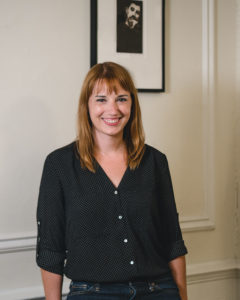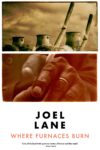
This essay first appeared in the Full Stop Quarterly, Issue #9. To help us continue to pay our writers, please consider subscribing.
Sara Batkie’s debut collection, Better Times, is the winner of the Prairie Schooner Book Prize in Fiction. Reading the nine stories in this collection, I was struck by how Batkie’s work contains so many pleasant contradictions. Stark, but beautiful. Propulsive, but resonant. Epic, but intimate. Frank, but bordering on the fantastic. The stories in Better Times focus on women throughout various points in history and manage to feel both timely and — wait for it — timeless. Far from struggling under the weight of these contradictions, the resulting collection is a seamless and exciting first book.
Seth Fried: Here’s a first line for the ages from your story “Lookaftering”: “Louisa hadn’t even realized she was pregnant when she gave birth to the eggs.” In other stories in Better Times, an entire community suffers from some sort of anterograde amnesia or nine Alaskans are stranded when their end of town breaks off into the ocean and floats away. The worlds of your stories are incredibly grounded, many of them feeling like unflinching observations of the world as it is, but throughout there are also these flourishes of the fantastic and the near-fantastic. Can you talk about what these elements mean to you and how you use them in your work?
Sara Batkie: I think it probably stems from my lifelong belief that strangeness is always permeating the mundane, but for a lot of us it’s easier to look past these things, to either brush off or rationalize something we don’t understand. Whereas I find the inexplicable to be incredibly rich territory for fiction. It’s a place to put the things we’re scared to confront in life. So I like exploring those kinds of baffling situations, but I’m not particularly interested in the causes. Possibly this is laziness on my part, but I like to think of it as a gift to the audience. I don’t, for example, provide any explanation for why Louisa gives birth to the eggs, and the story ends right before they’re about to hatch. Whatever the individual reader might imagine will come out of them is far more exciting than anything concrete I might put there. I was much more curious to discover how a young woman would confront this unusual dilemma. In order for the fantastical to work, at least for me, it has to comment in some way on the human world it’s intruding on. That’s where the allure lies for me, as a reader and a writer.
The stories in this collection are organized by era (The Recent Past, The Modern Age, The World to Come). Also, as the title suggests, time in general is an important thematic element holding these stories together. This seems particularly relevant, since current events have made it so that a lot of us are probably starting to think of our lives in terms of history and the era we’re living in. When you were writing these stories, was time your entry point? Did you think of a particular time and let a story grow out of that?
Not always. In fact, I rarely think about time when I’m first starting a story. There are exceptions, of course, like when I’m inspired by an actual historical figure or living person as I was with “When Her Father Was an Island.” But I usually start with a character or situation and then figure out what point in time makes the most sense for them after I’ve spent some time developing the plot. More than time, let’s say I’m interested in revising history, and that includes our current era and what might lie ahead (horrifying as that is to ponder these days). I want to tell the stories of the women who have been overlooked or dismissed, wherever in the centuries they might fall. I think they have some pretty surprising things to tell us.
The classic view of tragedy seems to be that if something bad happens to your character it should be because they’re flawed. Do you think that conception of tragedy is still relevant?
I’m not sure it was ever relevant for anyone beyond the Greeks. But as someone who has a certain level of privilege as a straight white person but also suffers from misogyny as a woman, I see it as an integral part of my job as an artist to make sure I’m addressing these sorts of systemic injustices in a way that’s true to the characters I’m creating. Misfortune is something that visits all of us at various points in our lives, no matter what our personal privileges might be. And all of us are flawed in some way. Tragedies don’t happen because of them, but often in spite of them. That’s where the great potential of a story lies, at least for me.
Could another way of looking at this classic view of tragedy be that the world of a story just needs to “talk” to your character’s interiority in some way? In other words, are the aspects of the world that you highlight in a given piece determined by your character’s internal make-up? For example, let’s say you’re writing about a character who has a problem with authority and so maybe the world of the story becomes defined by power relationships. Or is the nature of the world a predetermined variable in your stories and you get to know your characters by how they react to it?
Personally I almost always start with the character first and develop the setting based on how they perceive themselves in it, because I think all of us react to and interpret the world based on our own experiences with it. And as “Rashomon” so expertly demonstrated, a story can change drastically depending on who’s doing the telling. There are, of course, exceptions, as with the previously mentioned “When Her Father Was an Island,” which pretty much had to take place in Japan, even though the country is never mentioned by name in the story. Since I’ve never been there before myself, having an idea of how the culture of the country at that time informed the behavior of the people who lived there helped in the early development of the father and daughter. But that just assisted with the broad strokes; it was getting to know the characters as individuals that allowed me to pluck certain details from my head and put them on the page, like the pear tree farm the father fantasizes about because it’s where he first saw his wife. So it’s trial and error, of course. If I’m the god of my characters, I hope I’m a flexible one.
For me the best collections tend to contain a wide range of worlds while still feeling like a cohesive statement. Better Times is a perfect example of that for me. Can you offer us any insight on what the process of shaping a collection is like for you? Protracted metaphors are welcome. Is it like making a mixtape? A collage? Planning a scavenger hunt?
I’ll go with the mixtape metaphor, since I probably have the most hands on experience making those. In the same way you’re thinking about the mood you want to set and who you’re making the tape for, I was trying to keep in mind while picking and choosing which stories to place in the collection some similar themes and a general feeling I wanted to leave the reader with, which in the case of Better Times was a sort of uneasy, bittersweet nostalgia, even for things that might not have happened yet. I started with the six that had been previously published and then it was a matter of figuring out which pieces left in the “Stories” folder on my laptop felt the most polished and ready to go. Then after a certain point, I noticed that there were several pieces that took place earlier in the twentieth century, then several in the modern age, and then the one story set in the near future, so decided to group them into the three sections. From there, just as you have to pay attention to order on a mix, moving fluidly from fast to slow tempo and back again, I looked more closely at the voices of the stories, and was careful not to put similar sounding narrators too close to one another. I wanted to keep a sense of forward momentum and surprise, but also put together something that will be read all the way through rather than skipped around in, just as a tape is meant to be enjoyed. Hopefully I’ve succeeded.
Okay, now would you be so kind as to make us an actual mixtape we can listen to while reading Better Times?
Gladly. The first and last song here can be considered palate cleansers. The middle nine each match up to the corresponding numbered story in the collection:
- Something On Your Mind – Karen Dalton
- Love Vigilantes – New Order
- Teenage Spaceship – Smog
- The Ballad of Lucy Jordan – Marianne Faithfull
- What Are You Doing the Rest of Your Life? – Dusty Springfield
- Deathly – Aimee Mann
- New World Coming – Nina Simone
- Acrobat – Angel Olsen
- More Adventurous – Rilo Kiley
- Baby Won’t You Please Come Home – Bessie Smith
- Better Times – Beach House.
In other interviews, I’ve seen you mention the following artists as being influences on your work: Leonard Cohen, Nina Simone, Jane Campion, and Robert Altman. I’m fascinated by how fiction writers incorporate the influence of other media into their writing. Can you talk to us about how this type of influence works for you?
I’d say it’s a matter of being open and curious and appreciative of what artists working in other mediums want to say to you and seeing if that sparks anything you want to say back to them in your own work. With music, sometimes I rely on it to set a mood, though I rarely listen to anything with words when I’m actually writing. It’s too distracting. Even really recognizable classical music can be too much if I’m not in the groove yet. Cohen and Simone, though, were such introspective and inventive lyricists, and often very political ones, that I find sometimes just putting on one of their records can help me be more mindful of language and its powers. Film I think is useful for writers because it gives you new ways of seeing the world and people in it. Great filmmakers like Campion and Altman have very distinct eyes, so even if I could never explicitly imitate them with my prose, I can appreciate what they’re communicating visually and what draws their interest. They remind me to look beyond what’s right in front of me.
Let’s say fiction isn’t on the table for some reason. What other kind of artist could you see yourself as?
I’ve never shown much facility for songwriting, but I used to be a pretty strong singer and still enjoy the occasional karaoke outing. So maybe the lead vocalist of a band.
As a writer, this is the question I always skip down to in interviews: Do you have any favorite pieces of craft advice you can share with us?
You know, here’s the thing and I might come off sounding like a total dick, but when I was an aspiring writer, I always looked to craft advice because I wanted reassurance that what I was doing was “right.” Because I have always had to work a full time job, and continue to do so, and I don’t always get time to sit down at the end of the day and get back onto a computer after being on one for eight hours and try to put words together nicely, and I heard for so long from a lot of older white men, usually, that writers must have a “dedicated practice” and that it was important to write every day or you would never succeed. So my favorite craft advice is that is crap, and don’t listen to anyone who tells you what you “must” do. Figure out what works best for you and do that. But that’s me telling you what you must do, so who knows.
Seth Fried is a fiction and humor writer. He is the author of the novel The Municipalists and the short story collection The Great Frustration. He is a recurring contributor to The New Yorker’s “Shouts and Murmurs” and NPR’s “Selected Shorts.” His stories have appeared in Tin House, One Story, McSweeney’s Quarterly Concern, The Kenyon Review, Vice, and many others. He is also the winner of two Pushcart Prizes and the William Peden Prize. He is represented by Stacia Decker at Dunow, Carlson, & Lerner.
This post may contain affiliate links.







